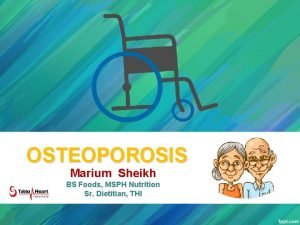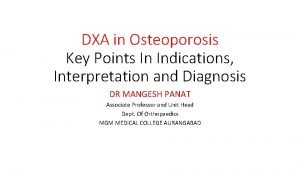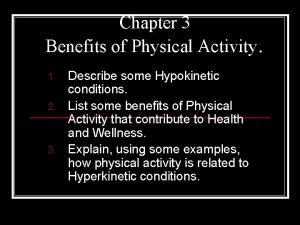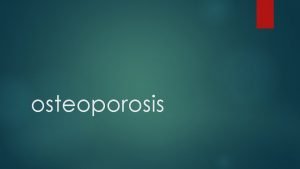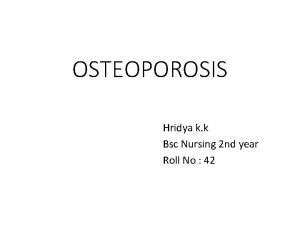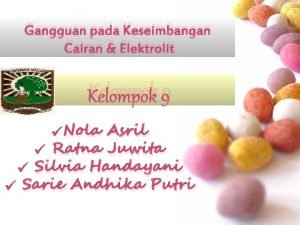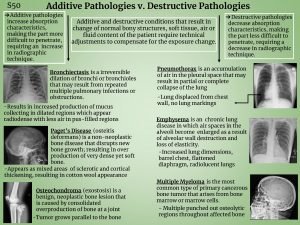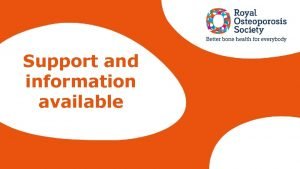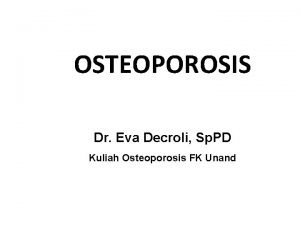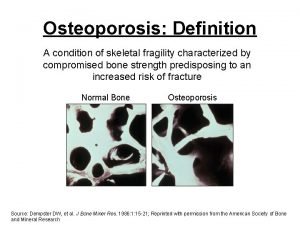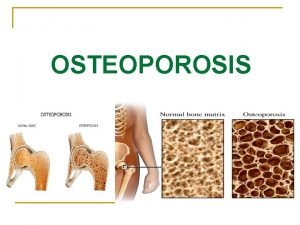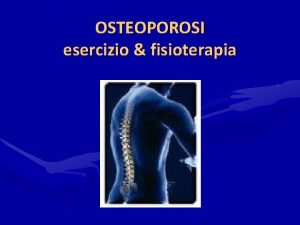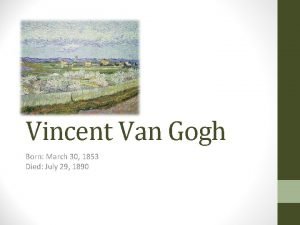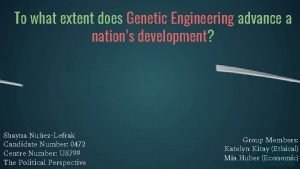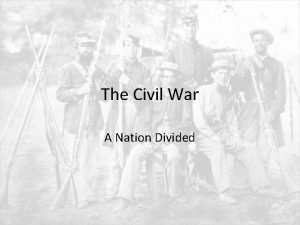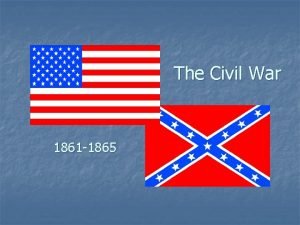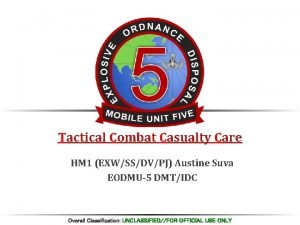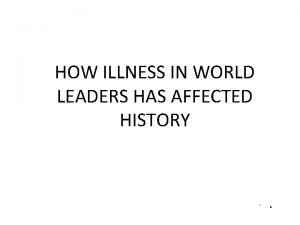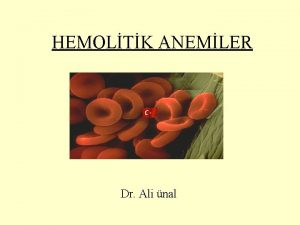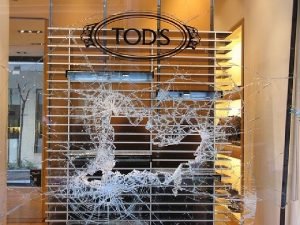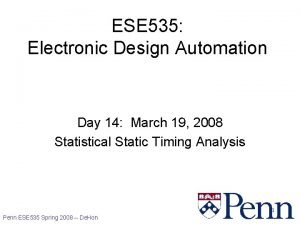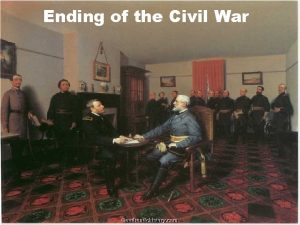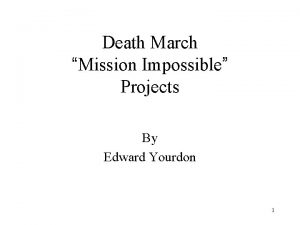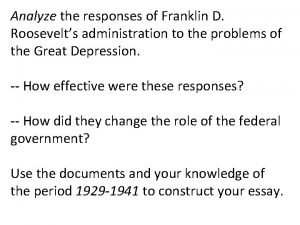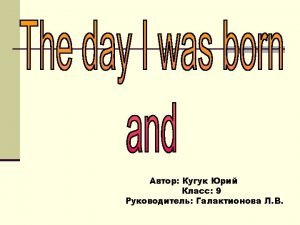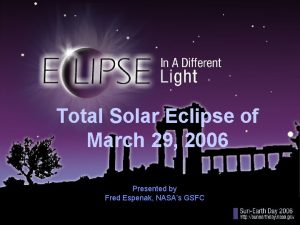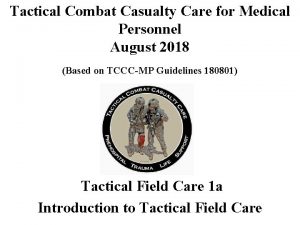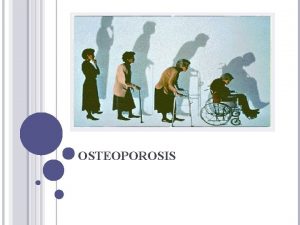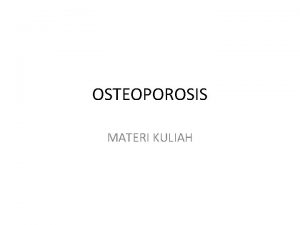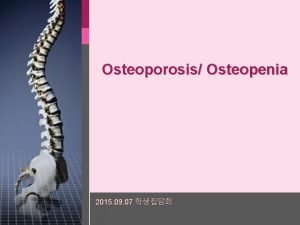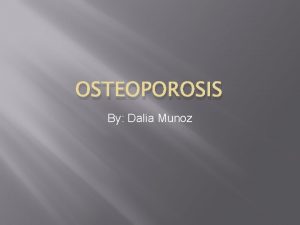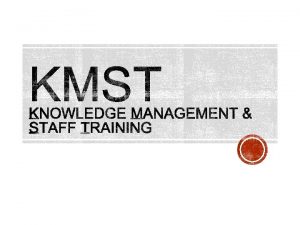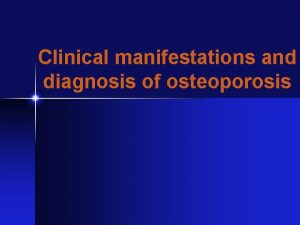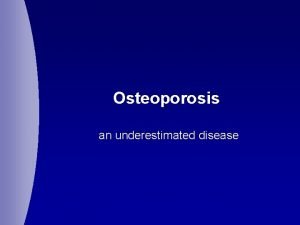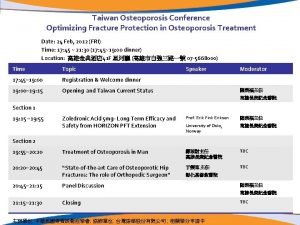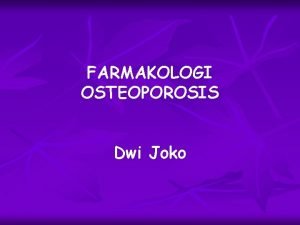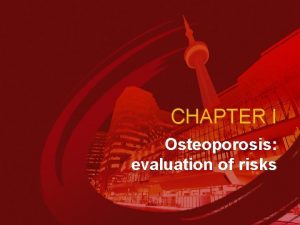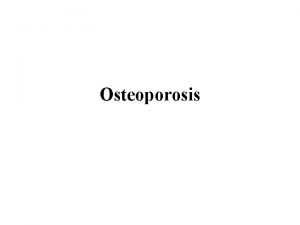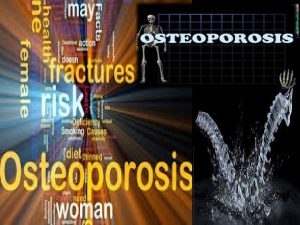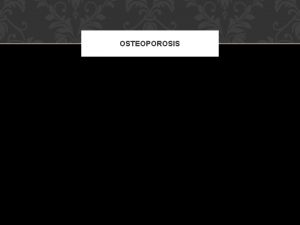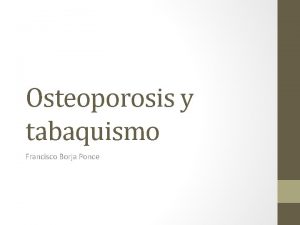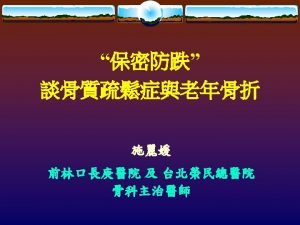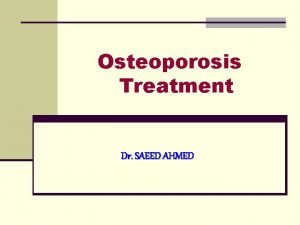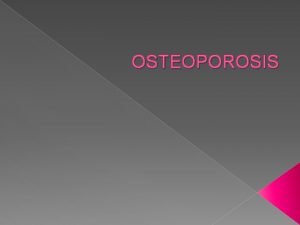Osteoporosis Updated March 2019 Introduction Osteoporosis Osteoporosis is





















































- Slides: 53

Osteoporosis Updated: March, 2019

Introduction Osteoporosis

Osteoporosis is “a disease of the bones that happens when you lose too much bone, make too little bone, or both. ” - National Osteoporosis Foundation Currently, there are 6 million people diagnosed with osteoporosis in the United States Most of them are FEMALE But MEN have worse outcomes Introduction

Anatomy Osteoporosis

Compared to men, women have: Cortical thickness Weaker bones: • Smaller bone cross-sectional area 1, 4 • Less cortical bone thickness 4 • Lower peak bone mass 1, 2 Higher risk for osteoporosis: • Less bone mineral density 2, 4 • Bone density that decreases more with age 1 Anatomy Normal Bone Osteoporosis

Physiology Osteoporosis

Cells of bone remodeling: RANK Ligand RANK Receptor Osteoprotegerin • Osteoblasts build bone • Osteoclasts resorb bone Osteobla Osteoclast sts Osteocla sts Proteins that regulate bone remodeling: • RANK Ligand stimulates osteoclasts 1 • Osteoprotegerin inhibits RANK Ligand 2 Physiology

Pathology Osteoporosis

Higher Peak Bone Mass 3, 4 Bone Mass (ra Meno pid p bo ause ne los s) 2 0 20 40 60 Age (in years) Pathology Men Women 80 100

Estrogen promotes bone formation 1 Osteoprotegerin RANK Ligand • After menopause, estrogen levels drop • Women experience rapid bone loss after menopause due to estrogen deficiency 2 Estrogen

Testosterone: • • Stimulates osteoblasts 3 Inhibits osteoclasts 3 Increases bone size and BMD 3 Mediated by an androgen receptor 3 Men with low testosterone are susceptible to osteoporosis. 3 Testosterone

Epidemiology Osteoporosis

• 200 million women worldwide suffer from osteoporosis • Approximately 30% of all postmenopausal women in the U. S. and Europe have osteoporosis. • At least 40% of these women, and 15 -30% of men, will sustain one or more fragility fractures in their remaining lifetime. Epidemiology

Estimated Annual Incidence: 2 • Total fractures: 9 million • Hip fractures: 1. 6 million • Forearm fractures: 1. 7 million • Vertebral fractures: 1. 4 million Fracture Incidence Hip Forearm Spine Humerus Other Sites

Fracture Comparison

Treatment Osteoporosis

Treatment

• Promotes bone formation and decreases bone resorption Mechanism of Action Application • First line treatment for osteoporosis in both men and postmenopausal women 1 Bisphonates • Approved in both sexes for the prevention and treatment of osteoporosis Aledronate 2, Risedronate 3 and Zoledronic Acid 4

Ibandronate (Boniva) Only FDA approved for treatment (not prevention) of osteoporosis in postmenopausal women Not FDA approved for males • Paucity of studies 1 • Similar pharmocokinetics in men and women 2 • Similar efficacy in men and women probable 3 Bisphonates

Drug Route/ Frequency Indicated for which gender Alendronate PO/QDay, QWeek Women Men Risedronate PO/QDay, QWeek, QMonth Women Men Ibandronate Vertebral Fracture RR Hip Fracture RR Nonvertebral RR NE Zoledronic Acid Bisphonates NE PO/QMonth Women IV/Q 3 Mont h IV/QYear RR = Risk Reduction Women Men NE = No effect demonstrated

Drug Vertebral Fracture RR Hip Fracture RR Nonvertebral RR Route/ Frequency Indicated for which gender Raloxifene NE NE PO QDay Women Calcitonin NE NE Nasal QDay SQ QDay Women Teriparatide SQ QDay Women Men Denosumab SQ Q 6 Months Women Men RR = Risk Reduction Other Agents NE = No effect demonstrated

Estrogen & Bone Metabolism

Estrogen’s protective role in bone metabolism has long been appreciated 1 Decline of estrogen in postmenopausal females provides a ready example of estrogen’s protective role in bone metabolism 2 Estrogen HRT in postmenopausal women has been shown to: • prevent bone loss (Maintain BMD) • decrease bone remodeling and incidence of vertebral fracture 3 HRT- Hormone Replacement Therapy Estrogen in Females

Testosterone’s influence on bone metabolism is minimal in both sexes 2 Testosteron e& estrogen decline with aging Estrogen has a greater role in preventing bone resorption in both males & females 2 1 Estrogen in Males

• Mechanism of Action: selective estrogen-receptor modulator • Benefits • Increases BMD of hip and spine in women 1 • Females: approved for treatment and prevention of osteoporosis in women. • Not approved in males 2 • Narrow study contexts 3, 5 • Was not shown to significantly impact BMD in males 4 Raloxifene

• Bazedoxifine/Conjugated Estrogen (Duavee) • Mechanism of Action: SERM that selectively stimulates lipid metabolism and bone, however, has no effect on the uterus and breast. • Benefits • FDA approved for • postmenopausal moderate/severe vasomotor symptoms • prevention of postmenopausal osteoporosis. • Increased hip and lumbar BMD Tissue Selective Estrogen Complex

• Bazedoxifene/Conjugated Estrogen (Cont’d) • Approved in Women for: 2 • prevention of osteoporosis • osteopenia • post menopausal vasomotor and sleep disturbances • Men: None of the three major clinical trials included men, despite that estrogen has been demonstrated to play a significant role in bone formation. 3, 4, 5 Tissue Selective Estrogen Complex

• Mechanism of Action • Analogous to endogenous calcitonin • Indications • Approved for the treatment (not prevention) of osteoporosis in women who are ≥ 5 years postmenopausal • Not utilized in men Calcitonin-Salmon

• Mechanism of Action: • Recombinant parathyroid hormone (PTH) • Stimulates bone formation. • Approved for: • Treatment & prevention of osteoporosis in men and postmenopausal women 1 • Especially those at high risk for vertebral fracture 2 Teriparatide (Forteo)

Significantly increased lumbar BMD from baseline levels 3 Extent of lumbar BMD increase similar in both males 1 and postmenopausal females 2 Teriparatide Efficacy

NOF Recommended Daily Intake: Calcium Men: 1000 mg Women: 1200 mg Vitamin D Men & Women: 800 – 1000 units Calcium & Vitamin D

Total Fracture Incidence • DIPART Group analysis of 7 major Vitamin D and Calcium trials in the US and Europe. • Analysis included 68, 500+ patients • Only 14% of subjects were males Calcium and Vitamin D

Hip Fracture Incidence Calcium and Vitamin D

• Efficacy: • Combination Calcium (1200 mg) and Vitamin D (800 mg) reduces the risk of hip, vertebral and total fractures in both men and women. 1 • Study Demographics • Men were understudied • 2010 DIPART Group Meta-Analysis: only 14% of 68, 500 subjects studied were men 1 • 2007 Tang et al. 2 Meta-Analysis included only 8% men 3 Calcium & Vitamin D

Mechanism of Action: monoclonal antibody; prevents osteoclast maturation. “RANK-L”, RANK-Ligand RANK-L Inhibitor (Denosumab)

• Approved to increase BMD in 1, 2 • Women: • With non-metastatic breast cancer • post-menopausal women with osteoporosis at high risk for fracture. • Men: 2 • With non-metastatic prostate cancer who are receiving Androgen Deprivation Therapy. • With osteoporosis who are at high risk for fracture. Denosumab (Prolia)

Efficacy in Males Increased: BMD at all skeletal sites (lumbar spine, femoral neck, trochanter, radius & total hip) Decreased: serum bone turnover markers, incidence of vertebral fracture in those with non-metastatic prostate cancer Denosumab

Efficacy in Females Increased vertebral, hip and non-vertebral BMD 1. Decreased incidence of vertebral, hip and nonvertebral fractures 1, 3 Denosumab

In Males, • No data for fracture incidence in males without nonmetastatic prostate cancer 1. • Few phase III clinical trials have thoroughly investigated the efficacy of Denosumab in males, though it has been shown to be a beneficial treatment option. In Females, • Major phase III clinical trials studied Denosumab efficacy in >2000 postmenopausal females 2– no equivalent in males. • Examples: FREEDOM, DEFEND, DECIDE & STAND studies 3 Denosumab Research Disparities

Prognosis Osteoporosis

90% 80% 70% 60% 50% 40% Men Women 30% 20% 10% 0% Return to Independent Living Independent Mobility Mortality within 1 Yr. Fracture Prognosis

Compared to men, Women: - Are almost twice as WOMEN likely to survive - Are more likely to return to home - Are more likely to return to walking independently Compared to women, Men: - Have higher early postoperative mortality -Are less likely to return to independent living or mobility. Fracture Morbidity

The Dubbo Osteoporosis Epidemiology Study 1 Men 197 out of 343 died Women 461 out of 952 died 60% 58% 56% 54% 52% 50% 48% 46% 44% 42% Men Fracture Mortality Women

80% 70% 60% 50% 40% Men Women 30% 20% 10% 0% Receive Treatment after Fracture 1 Receive Treatment within 1 Yr. 2 Osteoporosis Treatment after Hip Fracture

Risk Factors Osteoporosis

Cannot Change 1 Potential for Change 1 Menopause Smoking History of fracture in first-degree relative Low body weight (<127 lbs) Caucasian race Estrogen deficiency, including menopause onset <age 45 Excessive Alcohol Advanced age Low calcium intake (lifelong) Female Vitamin D Insufficiency Specific Diseases Specific Medications Sedentary – lack of weigh-bearing exercise Female Athlete Triad Risk Factors Eating disorders

Screening Osteoporosis

Criterion 1 Age-Based on Risk Factors Women • • Regardless of Gender • • • 65 years and older Men 70 years and older Postmenopausal, < 65 with 1+ risk 50 -70 years with factor(s) 1+ risk factor(s) Perimenopausal with specific high-risk factor associated with increased fracture risk Postmenopausal, discontinuing estrogen Fragility fracture (after age 50) High-risk condition or exposure to high-risk medication associated with low bone mass or bone loss Anyone being considered for pharmacologic therapy Screening

• The gold standard test for diagnosis 1 • Measures 1 • Spine • Hip • Forearm • Less radiation than in the environment 1 • Provides the T Score 1 DXA Scan

Diagnosis 1 T-Score 1 Normal BMD is within 1 SD of a healthy young adult: T-score > -1. 0 Osteopenia BMD is between 1. 0 and 2. 5 SD below that of a healthy young adult: T-score between -1. 0 and -2. 5 Osteoporosis BMD is 2. 5 SD or more below that of a healthy young adult: T-score < -2. 5 Established Osteoporosis BMD representing a T-score ≤ – 2. 5 and the presence of one or more fragility fractures T-Score Definitions

Screening is Cost-Effective in Women >651 Screening is NOT Cost-Effective in Men >701 Cost-Effectiveness

Gender Awareness Osteoporosis

• Osteoporosis considered a “Woman’s Disease” 1 • 20% of men will suffer from osteoporosis 1 • Research is biased towards women 2 • Men have worse outcomes 3 Gender Awareness
 Poland national anthem lyrics
Poland national anthem lyrics During _____ branching, only car is updated with adr
During _____ branching, only car is updated with adr Rpms meaning
Rpms meaning Grihalakshmi magazine march 2019
Grihalakshmi magazine march 2019 Kaggle march madness 2019
Kaggle march madness 2019 Pes statement for osteoporosis
Pes statement for osteoporosis Osteoporosis t score
Osteoporosis t score Is osteoporosis hypokinetic or hyperkinetic
Is osteoporosis hypokinetic or hyperkinetic Defination of osteoporosis
Defination of osteoporosis Subjective data for osteoporosis
Subjective data for osteoporosis Woc osteoporosis
Woc osteoporosis Additive pathology in radiography
Additive pathology in radiography Royal osteoporosis society leaflets
Royal osteoporosis society leaflets Osteoporosis
Osteoporosis Dr eva decroli
Dr eva decroli Osteoporosis definition
Osteoporosis definition God bone
God bone Osteoporosis defination
Osteoporosis defination International osteoporosis foundation
International osteoporosis foundation Whole muscle
Whole muscle When was vincent van gogh born
When was vincent van gogh born Source russia march
Source russia march March 1917 revolution
March 1917 revolution Abraham lincoln
Abraham lincoln Sherman's march significance
Sherman's march significance Path of sherman's march to the sea
Path of sherman's march to the sea Path of sherman's march to the sea
Path of sherman's march to the sea Nine line medevac
Nine line medevac American idol
American idol January february march april may
January february march april may Why rizal left london for paris in march 1899?
Why rizal left london for paris in march 1899? January february march
January february march Sherman's march to the sea
Sherman's march to the sea March 30 1981
March 30 1981 Talasemi minor kan tablosu
Talasemi minor kan tablosu 20 mile march
20 mile march Glasgow 5th march
Glasgow 5th march Glasgow 5 march 1971
Glasgow 5 march 1971 Sansculottes
Sansculottes 535 before 14 march
535 before 14 march Civil war map sherman's march to the sea
Civil war map sherman's march to the sea Drill and ceremony commands
Drill and ceremony commands Death march edward yourdon
Death march edward yourdon Performance art
Performance art Net of trade discount
Net of trade discount Meridel lesueur new masses january 1932
Meridel lesueur new masses january 1932 Chapter 31 section 4 aggressors invade nations
Chapter 31 section 4 aggressors invade nations Inurl:bug bounty intext:token of appreciation
Inurl:bug bounty intext:token of appreciation Chinese zodiac march
Chinese zodiac march March madness banner
March madness banner Astronomy picture of the day march 29 2006
Astronomy picture of the day march 29 2006 March algorthym
March algorthym Spring autumn
Spring autumn Type ce abrasive blasting respirator
Type ce abrasive blasting respirator





